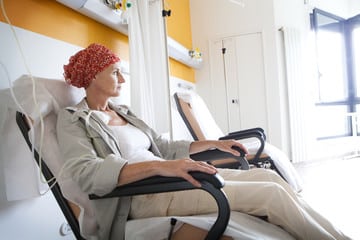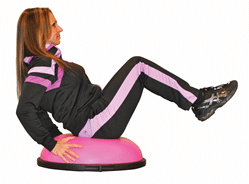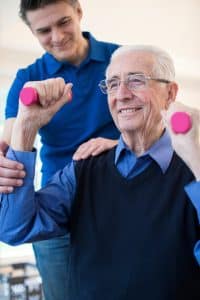The Benefits of Exercise During Cancer Recovery

One of the most important, if not THE most important part of recovery from the debilitating side-effects of cancer surgery and treatment is correcting postural deviations that are the result of muscle imbalances. We must re-educate the body to restore its’ normal balance. Most of us think of balance as one’s ability to stand without falling, but it actually represents the ability to stabilize and maintain a specific body position. Postural control is defined as the act of maintaining, achieving, or restoring a state of balance during any posture or activity. Therefore, it only makes sense that performing exercises to correct range of motion and postural deviations, while incorporating the aspect of balance, would yield the greatest results!
As individuals, we all have varying levels of kinesthetic awareness: sensitivity to the moment of our body through space that contributes to our ability to balance and move rhythmically and fluidly. This can be affected by many things; age, previous injuries, athleticism, and neuropathy. A fairly common side-effect of chemotherapy is peripheral neuropathy. Peripheral nerves carry information to and from the brain and carry signals to and from the spinal cord to the rest of the body. Peripheral neuropathy means these nerves don’t work properly. Peripheral neuropathy may be damage to a single nerve, or a group of nerves. Typical symptoms of neuropathy are related to the type of affected nerve. If a sensory nerve is damaged, common symptoms include numbness, tingling in the area, a prickling sensation, or pain. Pain associated with neuropathy can range from mild burning to an intense stabbing sensation. In some cases, a non-painful stimulus may be perceived as excruciating or pain may be felt even in the absence of a stimulus. Damage to a motor nerve is usually indicated by weakness in the affected area. If the problem with the motor nerve has continued over a length of time, muscle shrinkage, or lack of muscle tone may be noticeable.
This brings us to another very important aspect of balance and performance, proprioception. Proprioception is the ability to sense the position, location, orientation, and movement of the body and its parts. You can see how this could become challenging to someone who is affected by peripheral neuropathy and either loses sensation in their extremities or is fraught with constant pain in that area. If you have peripheral neuropathy in your hands, you may find it very difficult to articulate exercises that involve the use of weights or resistance bands. You can avoid those exercises and focus on the many exercises that do not require an external load to be placed on the muscles. If you have peripheral neuropathy in your feet, it is not advisable to perform high-impact activities. Choose exercises like riding a recumbent bike, or swimming (unless your doctor advises you otherwise), that are non-weight-bearing. Peripheral neuropathy may be temporary or, in some cases, chronic. You should listen to your body and respect whatever limitations it may place on you on a given day. Remember that you can still advance and work towards both your short-term and long-term personal fitness goals.

Exercising on balance discs or the BOSU® Balance Trainer will help you to increase your postural stability; your ability to maintain the position of your body, or more specifically, it’s’ center of mass, within specific boundaries of space. Many patients/survivors will be menopausal either from the natural aging process, or, from the early onset of menopause due to their cancer treatment(s). This will result in the cessation of estrogen production which increases their risk of osteoporosis; reduction in bone mineral density. You can increase your bone density by performing weight-bearing exercises. Couple that with balance and stability work, and it can dramatically reduce your risk of falling! Additionally, you will be strengthening the tendons and ligaments that are a vital part of ankle stabilization and injury prevention.
According to the Mayo Clinic, functional fitness exercises train your muscles to work together and prepare them for daily tasks by simulating common movements you might do at home, at work or in sports. While using various muscles in the upper and lower body at the same time, functional fitness exercises also emphasize core stability. In order to help you to improve your “functional fitness,” you must first understand what that means to you as an individual. As fitness professionals we have been taught that functional fitness is a sport-specific term; our goal has been to mimic movements required for a particular sport (throwing a baseball, swinging a tennis racquet or golf club, shooting a basketball, etc. Functional fitness in laymen’s terms is the ability to perform activities of daily living with relative ease, or, to mimic movements that a person will encounter in their day-to-day life. This may be the act of squatting (in order to get in and out of a chair or to lower/lift an object safely), shoulder flexion (in order to reach for something on a high shelf), triceps flexion/extension (in order to push oneself up from a chair or out of bed), etc. When considering functional training, your goal should be to move away from exercises that only focus on a single joint. Instead your goal becomes integrating the entire body so that all of the muscles work together synergistically. Part of this equation is, of course, the integration of balance and coordination as well as general body awareness (kinesthetic awareness).

When you introduce these aspects of training, you will learn how to manage your own bodyweight in establishing your center of gravity. This may sound like an easy task for those of you who have not been faced with any considerable physical challenges. To the elderly, or anyone recovering from surgery or an injury, it is a matter of re-establishing what was once, second-nature to that individual. The goal is to learn safe and efficient movements by learning how to use your mind and your body synergistically in stabilizing your joints. Throughout your exercise program you will be learning to re-establish overall body stability and alignment in order to find your center of gravity.In order to maintain postural stability, one must be able to maintain their center of gravity within specific stability and balance limits. This skill cannot be developed without training the neuromuscular system. This requires practice, training, and experience; all of which have been compromised following cancer surgery and treatment. No matter how fit or athletic you were prior to your diagnosis, you are starting from ground zero in the aftermath of treatment
Nervous system side effects are caused by many factors, including cancer, cancer treatments, other medications, or other disorders. The symptoms may appear soon after treatment or may appear several years after treatment. Possible causes of nervous system problems:
– cancer that has metastasized (spread) to the brain or spinal cord
– tumors growing in other parts of the body that press on nerves
– some types of chemotherapy may cause peripheral neuropathy
– radiation therapy
– surgery, if nerves are damaged during surgery to remove a tumor or to perform a biopsy
specific medications, including some anti-nausea drugs, opioid pain killers, and anticonvulsants
– infections causing swelling or inflammation of the brain, spinal cord, or inner ear
– other conditions or symptoms related to cancer or cancer treatments, including anemia(low number of red blood cells), dehydration, fatigue, stress, and depression
– other conditions or disorders not related to cancer, such as diabetes, vitamin deficiency, thyroid dysfunction, human immunodeficiency virus (HIV), stroke, Alzheimer’s disease, multiple sclerosis, and nerve injury.
Because muscles need to learn how to contribute to movement patterns through ongoing training and repetition, a structured exercise program, that incorporates the movements you need for everyday life, is essential. You can gradually and progressively learn how to control your muscular force output for any given movement. This begins with kinesthetic awareness that may need to be re-learned after treatment. Be patient and don’t get frustrated if you do not progress at a speed that you would have anticipated. Sometimes the best that you can do is to minimize the loss of function. I have worked with clients in which there is no marked progress over time. I consider the fact that there is no decline in performance a success story for those people. Set realistic expectations; be enthusiastic and optimistic, but also be a realist!
One of the most overlooked side-effects of radiation and lymph node removal is lymphedema. Lymphedema occurs when the lymph system is damaged or blocked.Fluid builds up in soft body tissues and causes swelling. It is a common problem that may be caused by cancer and cancer treatment. Lymphedema usually affects an arm or leg, but it can also affect other parts of the body. Lymphedema can cause long-term physical and psycho-social problems for patients. When the lymph system is working as it should, lymph flows through the body and is returned to the bloodstream. When part of the lymph system is damaged or blocked, fluid can not drain from nearby body tissues. Fluid builds up in the tissues and causes swelling. Lymphedema may be either primary or secondary:
– Primary lymphedema is caused by the abnormal development of the lymph system. Symptoms may occur at birth or later in life.
– Secondary lymphedema is caused by damage to the lymph system. The lymph system may be damaged or blocked by infection, injury, cancer, removal of lymph nodes, radiation to the affected area, or scar tissue from radiation therapy or surgery. Exercise can play a critical role in lymphatic drainage and lymphedema prevention or management. Exercise helps lymph fluid move through the lymphatic system. This helps to reduce/prevent lymphedema because exercise makes the muscles contract and push lymph through the lymph vessels. According to the Mayo Clinic, light exercises in which you move your affected limb may encourage lymph fluid drainage and help prepare you for everyday tasks, such as carrying groceries. Exercises shouldn’t be strenuous or tire you but should focus on gentle contraction of the muscles in your arm or leg.
In summary, an exercise that incorporates balance training, weight-bearing, and cardiovascular training, is going to have some, if not all, of the following benefits:
- increase kinesthetic awareness, proprioception, and postural stability
- increase bone density/reduce the risk of osteoporosis
- increase balance/minimize your risk of falling and breaking a bone
- strengthen ligaments and tendons of ankle complex/reduce risk of sprains and strains
- increase aerobic capacity
- increase lymphatic drainage
- increase core strength/minimize low back pain
- correct postural deviations/reduce pain and joint degeneration
- increase range of motion
- improve functional fitness and the ability to perform activities of daily living
About the author:

Andrea is a subject matter expert for Medical Wellness Association, chairperson for the Medical Fitness Foundation Education Advisory Board and on the advisory board for the MedFit Network .
Andrea is a 38-year cancer survivor and has/had 23 first-degree relatives diagnosed with cancer. In 2015 she lost her father, Morton, to complications of bladder cancer and prostate cancer, and myelodysplastic syndrome. Her mother is currently fighting stage 4 metastatic breast cancer after a 23-year remission.
At the age of eighteen, Andrea was diagnosed with thyroid cancer and underwent a complete thyroidectomy and radioactive iodine treatment. Following her surgery, Andrea was challenged with a new, sluggish metabolism, and weight gain. It was through her own personal struggles to regain her previous energy level and physique that Andrea decided to become a personal trainer. She wanted to be able to help others, like herself, who struggled with the same issues of weight gain and poor self-esteem. Andrea graduated from the University of MD in 1990 with a degree in Criminal Justice, but quickly realized that she was in the wrong profession. She avidly pursued a career as a personal trainer.
Andrea began training in 1992 and worked at the National Capital YMCA in Washington, D.C. She quickly worked her way up to Director of Personal Training and ran the department for several years. While working at the YMCA, Andrea started Leading Edge Fitness and EMPOWER- Energizing, Mobilizing, Post-Operative Workout Enhancing Recovery. In 1996 Andrea’s mom was diagnosed for the second time with breast cancer. She watched her mother struggle through the trauma of multiple surgeries, reconstruction, a frozen shoulder, and addiction to narcotics in order to cope with the pain associated with her surgeries.
Inspired by her mother, Andrea, along with a medical advisory board from Georgetown University, George Washington University, and Johns’ Hopkins University Medical Centers, set out to write “Essential Exercises for Breast Cancer Survivors.” The goal was to help the millions of men and women, like her mother, to gain back their strength, range of motion, and self-esteem (among other things), following breast cancer surgery and treatment. The book was published by Harvard Common Press in 2000. Shortly thereafter, Andrea founded The Breast Cancer Survivor’s Foundation, a 501c3 public charity—to better the lives of cancer survivors and their families.
Realizing that she is limited to helping a certain number of clients per week, Andrea founded The Cancer Exercise Training Institute in 2004 and developed the Cancer Exercise Specialist® and Breast Cancer Recovery BOSU® Specialist™ Advanced Qualifications for health and fitness professionals. Through this program she has been able to pass on her wealth of knowledge, and enable health and fitness professionals around the world, to work safely and confidently with cancer patients. Through CETI’s Advanced Qualification live workshops and home study, participants learn about twenty-six types of cancer and pediatrics, their surgeries, treatments, lymphedema identification, prevention, and treatment, reconstructive procedures, contraindications, side-effects and so much more. Following a comprehensive examination, attendees are awarded the Cancer Exercise Specialist® and/or Breast Cancer Recovery BOSU® Specialist ™Advanced Qualifications.
Andrea has presented the Cancer Exercise Specialist Workshop around the world and has been a guest speaker at IDEA World, Healthy Aging Summit, Asia Fitness Conference, CPTN Personal Training Conference, IRHSA, TSI Summit, Medical Fitness Tour, Kaiser Permanente Thriving with Cancer Conference, Winona State University – Survivors Unite, McHenry Community College, New York Institute of Technology, OHSU School of Nursing, Edwards Hospital, Georgetown University Hospital, Suburban/Johns’ Hopkins, Mennonite Cancer Foundation, South Georgia Medical Center, Cary Medical Center Lynchburg General Hospital, Chesapeake Regional Medical Center, Sibley Hospital, Memorial Hermann, Sandford Health System, Avera McKennan Prairie Cancer Center, Baptist Hospital East, Patricia Neal Rehab. Center, St. Mary’s, Baptist Health System, Southeast Georgia Cancer Coalition, and Fort Bliss Army Installation.
Andrea has written 17 books on the subject of cancer and exercise and is a sought after speaker and author. She has contributed to PFP Magazine, ACE Certified, ACE Blog, NOU Magazine, Club Solutions Magazine, Bethesda Today, Capital Gazette, NASM’s Training Edge Magazine, Lake Oswego Review, Portland Tribune, The Oregonian, The Tidings inHealthOhio Blog and News, Capital Style, The Examiner, The Washington Post, Dallas Morning News, 4Wholeness.com, SpecialFit, and has appeared in countless videos including the Heartflex Breast Cancer Recovery video and been a regular fitness expert on AMNW.
The Cancer Exercise Training Institute is considered the gold-standard of education in oncology exercise and has trained more individuals than any other organization in the world.
If you would like to speak to Andrea about an individualized cancer recovery program that includes lymphedema education and prevention, correcting muscle imbalances and improving range of motion, regaining strength, losing body fat, and enhancing your overall wellness to reduce your risk for second cancers and co-morbidities like diabetes, osteoporosis, heart and lung disease, contact her through the link below.
